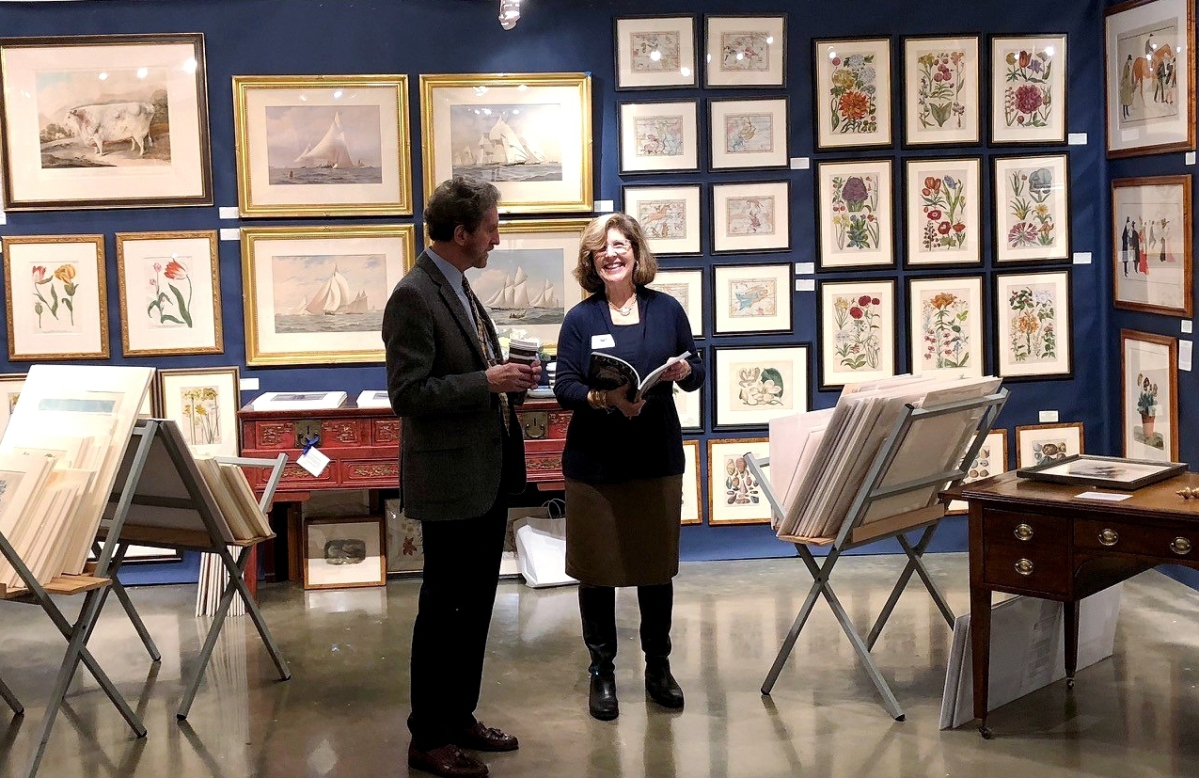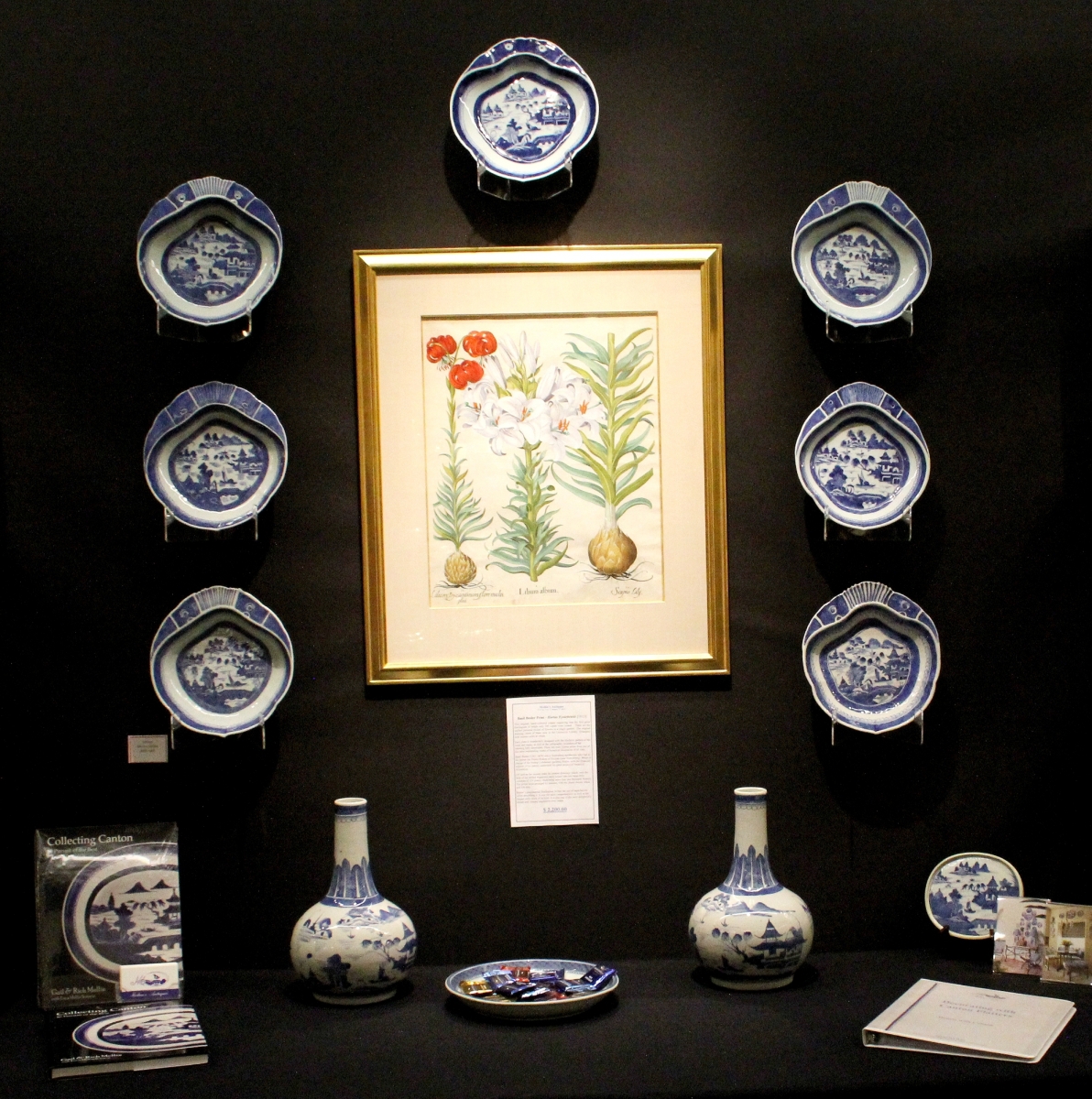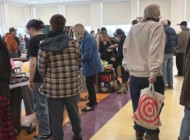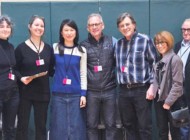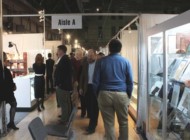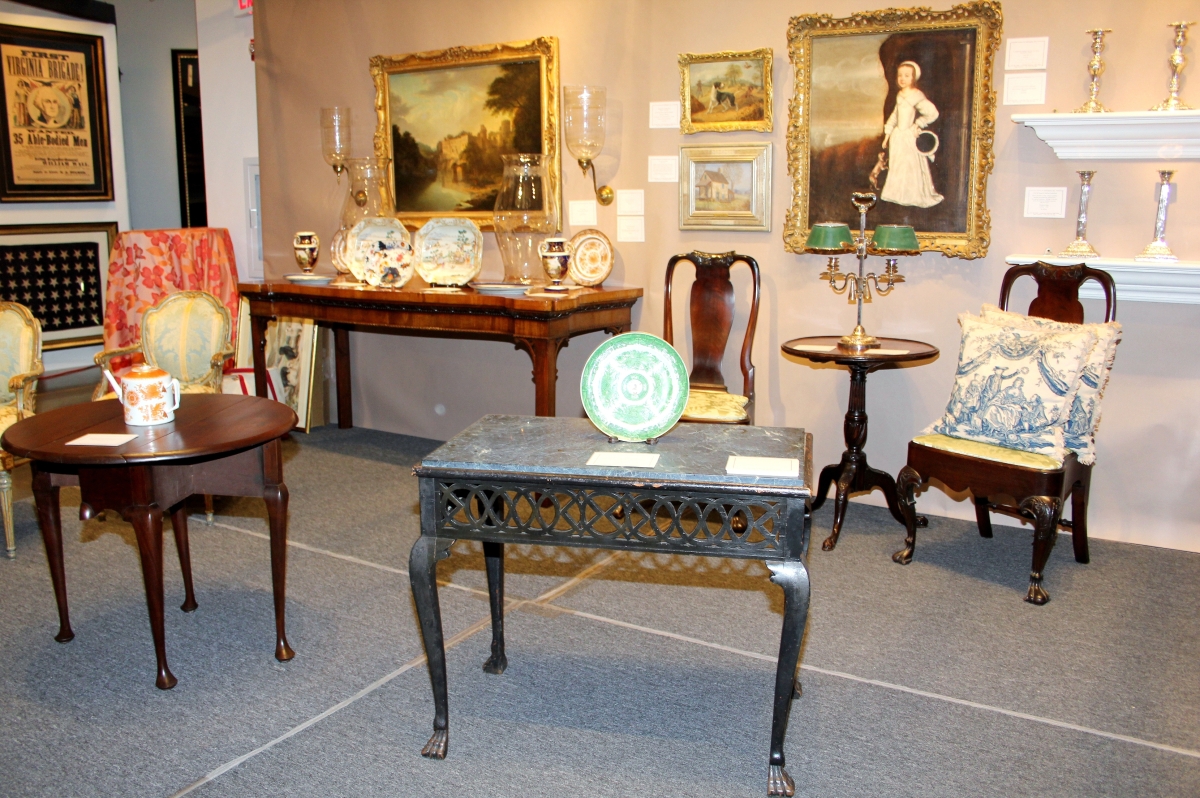
James M. Kilvington, Greenville, Del. In the foreground, the Irish slab-top table with a pierced skirt and brush feet dates to about 1750.
Review and Photos by Laura Beach
WASHINGTON, DC – Courtesy of Jonathan G. Willen, executive director of the Washington Winter Show, I was able to squeeze into a sold-out luncheon with Charlotte Moss, the designer whose new book, Charlotte Moss Entertains: Celebrations and Everyday Occasions, is officially out on April 10. Moss, who grew up in Virginia but lives in New York, summoned the memory of the woman in whose path she follows – fellow Virginian Nancy Lancaster (1897-1994), who moved to Britain, acquired the decorating firm Colfax & Fowler and sold the English country house style to American audiences.
Moss seemed an ideal spokesman for the Washington Winter Show, staged at American University’s Katzen Arts Center January 12-14. She embodies much of what is characteristic about the fair: its traditional, slightly Southern, demeanor and emphasis on hospitality and gracious living. Beyond Moss, the Washington Winter Show reflects the community’s keen interest in American history and politics, especially of the early national era, and, contrastingly, an internationalism that stems from the city’s many embassies, consulates, colleges, universities and immigrant communities.
Managed by Karen DiSaia with the help of her husband, Ralph, the Washington Winter Show is a marvel of committee work. It inherited its old-time charity-show structure from its predecessor, the Washington Antiques Show, but is lively and contemporary in outlook.
“This year the luncheon was completely oversold, with 504 guests. The preview party drew 650-plus guests. It is successful because it mixes the generations. We have people in their mid-20s all the way to their late 80s,” said Willen, a Washington, DC, events planner who was brought in to help manage the show’s volunteer operation and add efficiency to its business operations. Among the show’s many successes this year, said Willen, was its versatile theme, “The Charm of Chinoiserie,” and related loan show, “In The Chinese Style,” organized by Grant Quertermous, curator at Tudor Place Historic House and Garden in Washington.
One program near to Willen’s heart is “Sundaes on Sunday,” for children ages 8 to 12. “I created that program three years ago. We’ve had about 150 kids go through it. They come for a scavenger hunt and then get a sundae, scooped by me. One little girl came in with her mother, found a piece of Imari, researched it, then came back and bought it. It is a way of showing appreciation for the antiques business. Encouraging young people to collect can only help the business in the coming years,” Willen said.
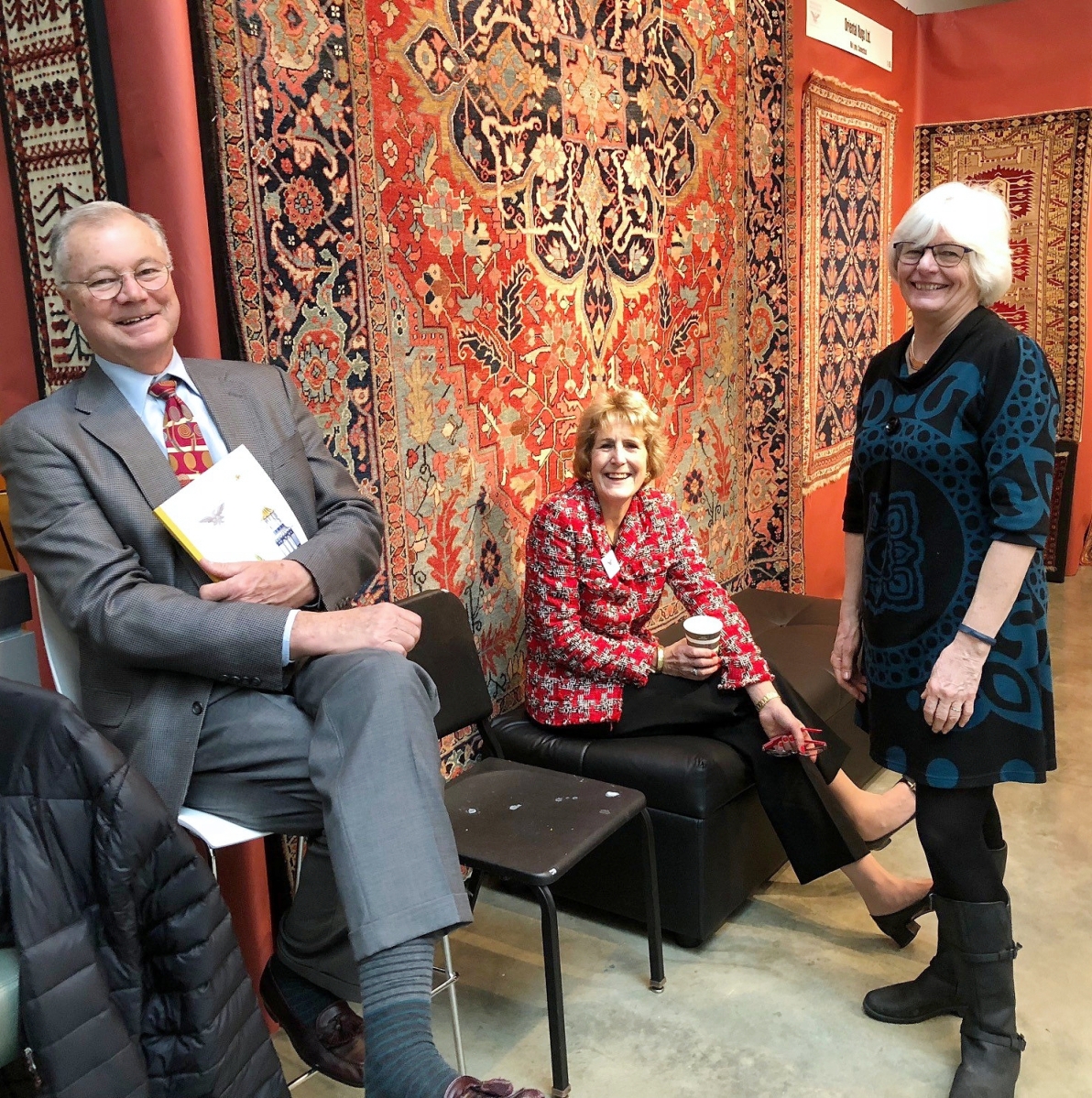
Karen DiSaia, right, manages the show with her husband, Ralph, left. The Oriental rug specialists set up across from Diana Bittel, center, with whom they orchestrate the Philadelphia Antiques and Art Show.
Karen DiSaia’s personal favorite is the Saturday evening “Jazz Night.” She says, “It started off as a way to get younger people into the show and has grown. Organizers are responsible for bringing other couples with them. The newcomers keep coming back and buying. ‘Jazz Night’ committee members go on to become members of the larger show committee.”
About sales, she added, “You can’t predict which exhibitors will sell well here, but some dealers had spectacular shows. It’s fascinating to me. Washingtonians move around a lot. They love art and antiques, and don’t seem to be worried about finding a place for them. On the whole, taste is somewhat formal here – though our Modern dealer, Brennan & Mouilleseaux, does quite well – and international in flavor.”
The Katzen Arts Center has much going for it, not least of all parking that is free to show patrons and a pleasant residential setting. The show is quirky from a design perspective, with 40-plus exhibitors setting up on three floors, some in trapezoidal spaces or in booths with curving walls.
“It’s challenging, but people love it. The show does not consist of little boxes side by side,” DiSaia said.
Making superb use of his third-floor spot at the top of a sweeping, central staircase, Pennsylvania dealer Jeff R. Bridgman arrayed historic American flags, a framed deck of Civil War playing cards and a beautifully conceived and carved American eagle with a 62-inch wingspan. Another carved eagle of roughly the same early Nineteenth Century date was on offer at Diana H. Bittel, Bryn Mawr, Penn.
Federalism as a design concept united Artemis Gallery’s cohesive display, which combined a set of six Philadelphia Federal side chairs with three Haines-Connelly school Philadelphia armchairs of circa 1800-10; a New York City scroll-back sofa from the workshop of Duncan Phyfe, circa 1810; and a Boston satinwood veneered worktable, school of John Seymour, Boston, circa 1810. To this, the North Salem, N.Y., dealer added printed ceramics and textiles, and a reverse painting on glass portrait of George Washington by William Matthew Prior, circa 1860.
Over a circa 1790 bottle case on stand attributed to Norfolk, Va., or Baltimore, Alexandria, Va., dealer Sumpter Priddy III hung an important, early Nineteenth Century Pennsylvania landscape, circle of Russell Smith (1812-1896).
Also from Alexandria, Taylor Thistlethwaite showed the oil on canvas “Dusk at Harper’s Ferry, West Virginia” of 1850 with a pair of cast-iron whippets attributed to J.W. Fiske & Company, New York, 1880; a rare Bermuda Queen Anne cedar card table with Spanish feet, circa 1700-25; and a Philadelphia tambour desk of 1800-25.
Traditional New England fare was plentiful at Mark and Marjorie Allen, Laconia, N.H., who dressed a Connecticut Queen Anne dining table of circa 1760 and a Boston flat-top highboy of circa 1750 with Dutch delft.
W.M. Schwind Jr Antiques and Fine Art, Yarmouth, Maine, featured a vivid yellow paint-decorated Maine dressing table of circa 1830, six stenciled Windsor side chairs with bamboo turnings and a Massachusetts cherry and figured maple worktable whose top was inlaid with figures of whales.
Bob and Claudia Haneberg have deep roots in the Washington area. Bob, a proud graduate of the United States Coast Guard Academy and former Coast Guard captain, became a full-time antiques dealer after retiring from the service. The couple returned to southeastern Connecticut, where they grew up, but still have children in the Washington area. Mounted against a deep blue background, their display, mingling handsome mahogany furniture and Chinese export art, hinted at their love of coastal style. Highlights included a Mid-Atlantic Pembroke table whose mate is at Winterthur Museum, a matched set of four sterling silver George II candlesticks by the Cafes, father and son; and an attributed Joseph Goodhue Chandler (1813-1884) painting of a boy in blue holding a whip.
“People in DC entertain. They like more formal things here,” Bob said. There were bargains in American furniture to be had at Allen Antiques, the Hanebergs and elsewhere. Boyd’s Antiques of Flourtown, Penn., sold well.
Nobody mixes American, English and Continental high-style furniture and accessories better than Delaware dealer James Kilvington, whose booth was anchored by an Eighteenth Century Irish slab-top table with a pierced apron and brush feet.
Looking glass authority Gary Sergeant Antiques of Connecticut hung an enormous George I giltwood mirror in the manner of James Moore and John Gumley, first quarter of the Eighteenth Century, on the outside of his stand.
The Norwoods, American folk art dealers from Maryland, offered a prized Burlington County, N.J., house sampler stitched by Rebecca Walker in 1798 and portrait miniatures of Daniel and Anne Miles Guyton painted by J. Darling, Richmond, Va., 1841.
“It’s unusual because it’s a miniature,” said Paul Vandekar, gesturing to a dated 1979 chest decorated by Cape Cod folk artist Ralph Cahoon.
A fancifully painted overboard from a carousel was a highlight at Village Braider Antiques of Plymouth, Mass.
“I’m a local,” said new exhibitor Stella Rubin, the Darnestown, Md., dealer in quilts and jewelry. A highlight of her display was a crazy quilt in superb condition with characteristic Aesthetic Movement detail.
“I just got a collection of early English mourning jewelry,” Massachusetts dealer Sandy Jacobs said, pulling out a gold and glass pendant marked with a skull and crossbones on one side and the date May 12, 1704, on reverse.
One appreciates the distinctive eye and thoughtful perspective of Joel Fletcher and John Copenhaver, fine arts specialists from Fredericksburg, Va., who showcased three Nineteenth Century landscapes suggestive of Martin Johnson Heade’s Luminist rambles in the tropics. The paintings were in fact by Norton Bush (1834-1894), a New York-born artist and student of Jasper F. Cropsey who settled in California and is known for still-undervalued paintings inspired by sketching trips to Central and South America. In 2012, Coeur D’Alene sold “Gatun Lake, Panama” by Bush for $58,500, the auction record.
Other interesting fine arts specialists in the Washington Winter Show are Kelleher Fine Art, whose focus is Belgian School painting; Carole Pinto and Solomon Suchard, whose fortes are French painting; and David Brooker, an Englishman who maintains a presence in the States, offering small paintings – mainly sporting, marine and landscape works – that fit well in traditional decorating schemes.
New to the show this year was gardens and architectural specialist Withington and Company Antiques. Portsmouth, N.H., dealer Bob Withington, known for his imaginative displays, furnished a bedchamber with a Dutch colonial bed from Jakarta, then linked the room to a garden enclosure ornamented with a pair of cast concrete figures of Classical maidens.
The 2019 Washington Winter Show is scheduled for January 11-13, with a preview party on Thursday evening, January 10. For additional information, www.washingtonwintershow.org or 202-248-7159.

